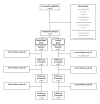The effects of adding a six-month Pilates exercise program to three months of traditional community-based pulmonary rehabilitation in individuals with COPD: a prospective cohort study
- PMID: 38828206
- PMCID: PMC11144029
- DOI: 10.29390/001c.117966
The effects of adding a six-month Pilates exercise program to three months of traditional community-based pulmonary rehabilitation in individuals with COPD: a prospective cohort study
Abstract
Introduction: Pilates exercise may complement traditional pulmonary rehabilitation in individuals with chronic obstructive pulmonary disease (COPD). The objective was to analyze the effects of adding a six-month Pilates exercise program to a three-month pulmonary rehabilitation for individuals with COPD.
Methods: Thirty-five participants with COPD (GOLD B) were assigned to the intervention (n=14) or control (n=21) group. Both groups received an initial three months of a pulmonary rehabilitation program. The intervention group further underwent six months of pilates. Participants were evaluated at baseline and at three, six, and nine months. Lung function and strength of respiratory muscles were defined as primary outcomes. Secondary outcomes included cardiac, physical function, and exacerbation episodes.
Results: There were no consistent statistically significant differences between groups for the lung function outcomes (p\<0.05). Maximal inspiratory and expiratory pressure increased significantly at three months in both groups (p\<0.05). It was significantly superior in the intervention group at nine months for maximal inspiratory pressure (p=0.005) and six and nine months for maximal expiratory pressure (p=0.027 and p\<0.001, respectively). Changes in muscle strength (knee extension and handgrip) were comparable between groups (p>0.05), but exercise-induced fatigue and balance were significantly superior in the intervention group at the six- and nine-month follow-ups (p\<0.05).
Discussion: Pilates exercise programs may be implemented to augment traditional pulmonary rehabilitation with the goal of improving the strength of respiratory muscles.
Conclusion: Adding a Pilates exercise program to pulmonary rehabilitation resulted in superior strength of respiratory muscles, higher resistance to exercise-induced fatigue, and improved balance.
Keywords: COPD; Chronic Obstructive Pulmonary Disease; Dyspnea; Pilates; Pulmonary rehabilitation; Respiratory rehabilitation.
Conflict of interest statement
All authors have completed the ICMJE uniform disclosure form and declare no conflict of interest.
Figures



Similar articles
-
Cycle ergometer and inspiratory muscle training offer modest benefit compared with cycle ergometer alone: a comprehensive assessment in stable COPD patients.Int J Chron Obstruct Pulmon Dis. 2017 Sep 6;12:2655-2668. doi: 10.2147/COPD.S140093. eCollection 2017. Int J Chron Obstruct Pulmon Dis. 2017. PMID: 28919733 Free PMC article. Clinical Trial.
-
A long-term pulmonary rehabilitation program progressively improves exercise tolerance, quality of life and cardiovascular risk factors in patients with COPD.Eur J Phys Rehabil Med. 2013 Aug;49(4):491-7. Epub 2013 Mar 13. Eur J Phys Rehabil Med. 2013. PMID: 23480981
-
The influence of inspiratory muscle training combined with the Pilates method on lung function in elderly women: A randomized controlled trial.Clinics (Sao Paulo). 2018;73:e356. doi: 10.6061/clinics/2018/e356. Epub 2018 Jun 18. Clinics (Sao Paulo). 2018. PMID: 29924184 Free PMC article. Clinical Trial.
-
Meta-analysis of the Effect of a Pulmonary Rehabilitation Program on Respiratory Muscle Strength in Patients with Chronic Obstructive Pulmonary Disease.Asian Nurs Res (Korean Soc Nurs Sci). 2019 Feb;13(1):1-10. doi: 10.1016/j.anr.2018.11.005. Epub 2018 Nov 24. Asian Nurs Res (Korean Soc Nurs Sci). 2019. PMID: 30481604 Review.
-
Active mind-body movement therapies as an adjunct to or in comparison with pulmonary rehabilitation for people with chronic obstructive pulmonary disease.Cochrane Database Syst Rev. 2018 Oct 10;10(10):CD012290. doi: 10.1002/14651858.CD012290.pub2. Cochrane Database Syst Rev. 2018. PMID: 30306545 Free PMC article.
References
-
- Global, regional, and national age-sex specific mortality for 264 causes of death, 1980-2016: a systematic analysis for the Global Burden of Disease Study 2016 [published correction appears in Lancet. 2017 Oct 28;390(10106):e38] GBD 2016 Causes of Death Collaborators 2017Lancet. 390(10100):1151–1210. doi: 10.1016/S0140-6736(17)32152-9. doi: 10.1016/S0140-6736(17)32152-9. - DOI - DOI - PMC - PubMed
-
- Trends and risk factors of mortality and disability adjusted life years for chronic respiratory diseases from 1990 to 2017: systematic analysis for the Global Burden of Disease Study 2017 [published correction appears in BMJ. 2020 Aug 6;370:m3150] Li X., Cao X., Guo M., Xie M., Liu X. 2020BMJ. 368:m234. doi: 10.1136/bmj.m234. doi: 10.1136/bmj.m234. - DOI - DOI - PMC - PubMed
-
- Global Strategy for the Diagnosis, Management, and Prevention of Chronic Obstructive Lung Disease: the GOLD science committee report 2019. Singh D., Agusti A., Anzueto A.., et al. 2019Eur Respir J. 53(5):1900164. doi: 10.1183/13993003.00164-2019. doi: 10.1183/13993003.00164-2019. - DOI - DOI - PubMed
LinkOut - more resources
Full Text Sources
